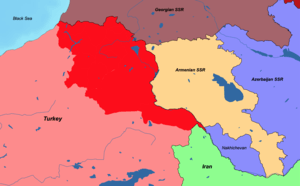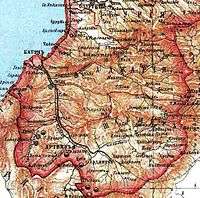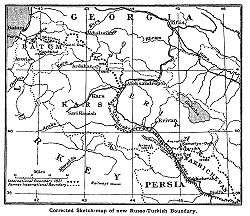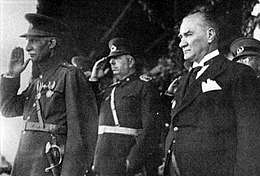Treaty of Kars
The Treaty of Kars (Turkish: Kars Antlaşması, Russian: Карсский договор, tr. Karskii dogovor, Georgian: ყარსის ხელშეკრულება, Armenian: Կարսի պայմանագիր, Azerbaijani: Qars müqaviləsi) was a peace treaty that established the common borders between Turkey and the three Transcaucasian republics of the Soviet Union (today the independent republics of Armenia, Georgia, and Azerbaijan).[3][4] The treaty was signed in the city of Kars on 13 October 1921.[1][2]
 Turkish gains (dark red) in the Treaty of Kars (1921) | |
| Type | Peace Treaty |
|---|---|
| Signed | 13 October 1921[1] |
| Location | Kars, Turkey |
| Condition | Ratification |
| Signatories | |
| Languages | Russian, French[2] |
Signatories of the Treaty of Kars included representatives from the Grand National Assembly of Turkey, which in 1923 would declare the Republic of Turkey, and from the Armenian, Azerbaijani, and Georgian Soviet republics with the participation of the Russian SFSR. The latter four parties would become constituent parts of the Soviet Union after the victory of the Bolsheviks in the Russian Civil War and the December 1922 Union Treaty.[1][2]
The treaty was the successor treaty to the earlier Treaty of Moscow of March 1921. Most of the territories ceded to Turkey in the treaty were acquired by Imperial Russia from the Ottoman Empire during the Russo-Turkish War of 1877–1878.[5] The only exception was the Surmali region, which had been part of the Erivan Khanate of Iran before it was annexed by Russia in the Treaty of Turkmenchay after the Russo-Persian War of 1826–28.[6]
Signatories
The treaty was signed by the Turkish Provisional Government Representative General Kâzım Karabekir, MP and Commander of Eastern Front Veli Bey, MP Mouhtar Bey, and Ambassador Memduh Şevket Pasha, Soviet Russian Ambassador Yakov Ganetsky, Soviet Armenian Minister of Foreign Affairs Askanaz Mravyan and Minister of Interior Poghos Makintsyan, Soviet Azerbaijani Minister of State Control Behboud Shahtahtinsky, and Soviet Georgian Minister of Military and Naval Affairs Shalva Eliava and Minister of Foreign Affairs and Financial Affairs Aleksandr Svanidze.[1]
Terms
The Treaty of Kars reaffirmed the terms of the earlier Treaty of Moscow concluded in 1921 between the Grand National Assembly of Turkey and the Russian SFSR. It defined the boundaries between the new Turkish Republic and all three Transcaucasian republics.

Georgia and Adjara
The Kars treaty provided for the territory of the former Imperial Russian Batum Oblast to be divided. The southern half of the former oblast, largely correspondent to the Artvin Okrug with the city of Artvin, would be annexed to Turkey.[3] The northern half, largely correspondent to the Batum Okrug with the strategic port city of Batum, would become part of Soviet Georgia as the Adjar ASSR (present-day Adjara).[3] The treaty required that the region be granted political autonomy due to the largely Muslim local population and that it implement "an agrarian system in conformity with its own wishes."[2] Caucasus scholar Charles King referred to this part of the treaty as a "rare instance in international law in which the internal administrative structure of one country has been secured by a treaty with another."[4] Additionally, the treaty guaranteed "free transit through the port of Batum for commodities and all materials destined for, or originating in, Turkey, without customs duties and charges, and with the right for Turkey to utilize the port of Batum without special charges."[2]

Armenian-Turkish border
The treaty created a new boundary between Turkey and Soviet Armenia, defined by the Akhurian (Arpachay) and Aras Rivers. Turkey obtained the territory of the former Kars Oblast of the Russian Empire, including the cities of Kars, Ardahan, and Olti, Lake Childir, and the ruins of Ani.[1] From the former Erivan Governorate, it also obtained the Surmalinsky Uyezd (Surmali), with Mount Ararat, the salt mines of Kulp (Tuzluca), and the city of Igdyr, as well as the Aras corridor, a narrow strip of land between the Aras and Lower Karasu Rivers that had been part of the Erivansky Uyezd.[7]
According to the memoirs of Simon Vratsian, the last Prime Minister of the First Armenian Republic, the Bolsheviks attempted to renegotiate the status of Ani and Kulp and retain them as part of Soviet Armenia. Ganetsky emphasized the "great historical and scientific value" of Ani for the Armenians and declared Kulp to be an "inseparable part of Transcaucasia."[8] However, Turkey refused to renegotiate the terms agreed upon in the Moscow treaty, much to the disappointment of the Soviet side.[8] Most of the Armenian territories ceded to Turkey had already been under Turkish military control since the Turkish–Armenian War.[9] The treaty required Turkish troops to withdraw from an area roughly corresponding to the western half of Armenia's present-day Shirak Province, including the city of Aleksandropol (Gyumri).[1]
Azerbaijan and Nakhichevan
Article V of the treaty established the region of Nakhichevan as an autonomous exclave under the political jurisdiction (protectorate) of Soviet Azerbaijan. The new autonomous Nakhichevan territory comprised the former Nakhichevansky Uyezd, the Sharur part of the Sharur-Daralagezsky Uyezd, and the southernmost parts of the Erivansky Uyezd of the former Erivan Governorate.[9] In 1924, the area was officially declared the Nakhichevan ASSR subordinate to the Azerbaijan SSR.[10] The creation of this new autonomous republic allowed Azerbaijan to share a common 15-km boundary with the now-Turkish-controlled Aras corridor.[11] In 1991, independent Azerbaijan declared itself the successor of the Democratic Republic of Azerbaijan (1918-1920) and not of the Azerbaijan SSR (under the protectorate of which Nakhichevan was transferred by Kars treaty).
Impact on Turkish-Iranian relations

The Kars treaty also impacted Turkish-Iranian relations. The annexation of Surmali and the Aras corridor now gave Turkey a slightly more extensive border with Iran. In the late 1920s, the Kurdish Ararat rebellion erupted in the vicinity of Mount Ararat. As Turkey attempted to quash the rebellion, the Kurdish rebels fled across the Iranian border to the eastern flank of Lesser Ararat, which they used "as a haven against the state in their uprising."[12] In response, Turkey crossed the border with Iran and occupied the region.[13] The Lesser Ararat area became the subject of discussion between Turkish and Iranian diplomats in border delineation talks. In Tehran in 1932, Iran agreed to cede the area to Turkey in exchange for some territories further south.[14]
However, the agreement was delayed due to objections from some Iranian diplomats who viewed the Lesser Ararat area as strategically important and who also questioned the validity of the Treaty of Kars.[15] These diplomats felt that Turkey did not have a legitimate claim to the territory of Surmali, which had been part of Iran before it was ceded to Imperial Russia in the Treaty of Turkmenchay.[15] In addition, because the wording of the Turkmenchay Treaty was vague, they advocated annexing parts of the area.[15] After a constructive meeting with Mustafa Kemal Atatürk in Ankara in 1934, Reza Shah, who initially favored annexing the Aras corridor, finally ordered his diplomats to drop any objections and accept the new border agreements.[16]
Attempted annulment by the USSR
After World War II, the Soviet Union attempted to annul the Kars treaty and regain its lost territory. According to Nikita Khrushchev, deputy premier Lavrentiy Beria goaded his fellow Georgian Joseph Stalin into taking action on the issue, insisting on the return of historical Georgian territories.[17][18] Stalin eventually agreed and on 7 June 1945, Soviet Foreign Minister Vyacheslav Molotov informed the Turkish ambassador in Moscow that the provinces of Kars, Ardahan, and Artvin should be returned to the USSR, in the name of both the Georgian and Armenian Soviet republics.[18][19] Ankara found itself in a difficult position: it wanted good relations with Moscow but at the same time refused to give up the territories. Turkey was in no condition to fight a war with the Soviet Union, which had emerged as a superpower after the Second World War.[18] Soviet territorial claims to Turkey were supported by the Armenian Catholicos George VI and by all shades of the Armenian diaspora, including the anti-Soviet Armenian Revolutionary Federation.[18] The Soviet government also encouraged Armenians abroad to repatriate to Soviet Armenia in support of its claims.[19][20]
The British and the Americans opposed the Soviet territorial claims against Turkey. As the Cold War began, the American government saw the claims as part of an "expansionist drive by a Communist empire" and viewed them as reminiscent of Nazi irredentist designs over the Sudetenland in Czechoslovakia.[18] The State Department was concerned about the strategic military significance of the Kars plateau to the Soviets.[21] They concluded that their earlier support for Armenia since President Woodrow Wilson (1913-1921) had expired since the loss of Armenian independence.[21] The USSR also requested a revision of the Montreux Convention and a military base on the Turkish Straits.[19] The State Department advised US President Harry S. Truman to support Turkey and oppose the Soviet demands, which he did. Turkey joined the anti-Soviet NATO military alliance in 1952.[21]
Following the death of Stalin in 1953, the Soviet government renounced its territorial claims on Turkey as part of an effort to promote friendly relations with the Middle Eastern country and its alliance partner, the United States.[20] The USSR continued to honor the terms of the Kars treaty until its dissolution in 1991. However, according to Christopher J. Walker, Moscow revisited the treaty in 1968, when it attempted to negotiate a border adjustment with Turkey in which the ruins of Ani would be transferred to Soviet Armenia in exchange for two Azerbaijani villages in the area of Mount Akbaba. However, according to Walker, nothing resulted from these talks.[22]
History since 1991
Position of Armenia
After the dissolution of the Soviet Union, the post-Soviet governments of Russia, Georgia, and Azerbaijan accepted the Treaty of Kars. Armenia's position is different, due to the absence of diplomatic relations between Turkey and Armenia. In December 2006, Yerevan's then-Foreign Minister Vartan Oskanian said that Armenia accepts the Kars treaty as the legal successor to the Armenian SSR, but noted that Turkey was not adhering to the terms of the treaty.[23] Specifically, Article XVII of the treaty called for the "free transit of persons and commodities without any hindrance" among the signatories and that the parties would take "all the measures necessary to maintain and develop as quickly as possible railway, telegraphic, and other communications."[2] However, due to tension between Armenia and Azerbaijan over Nagorno-Karabakh, Turkey closed its land border with Armenia and severed diplomatic ties with it, thus violating this article. Oskanian stated that by this action, Turkey was putting the validity of the treaty into doubt.[23]
Position of the Armenian Revolutionary Federation
The Treaty of Kars is overtly rejected by the Armenian Revolutionary Federation. The ARF specifically condemns the treaty as a "gross violation of international law" and argues that, because the three Transcaucasian republics were under the control of Moscow in 1921, their independent consent was questionable.[24] The ARF also questions the validity of the treaty based on the authorities of the sides that concluded it. They contend that the Grand National Assembly of Turkey had no legal authority to sign international treaties.[24] In addition, they argue that because the USSR was not founded until 1922, and therefore not a recognized state, it was also "not a subject of international law and, naturally, its government had no authority to enter into international treaties."[24]
Aftermath of the 2015 Russian Sukhoi Su-24 shootdown
Following the shootdown of the Russian Sukhoi Su-24 over the Syria–Turkey border in November 2015 and the rise of Russo-Turkish tensions, members of the Communist Party of Russia proposed annulling the Treaty of Moscow and by extension the Kars treaty.[25][26] Initially, the Russian Foreign Ministry considered this action in order to send a political message to the government of Turkish President Recep Tayyip Erdoğan.[25] However, Moscow ultimately decided against it in its effort to de-escalate tensions with Ankara.[27]
See also
| Wikimedia Commons has media related to Treaty of Kars. |
Footnotes
- (in Russian) Договор о дружбе между Армянской ССР, Азербайджанской ССР и Грузинской ССР, с одной стороны, и Турцией - с другой, Заключенный при участии РСФСР в Карсе Archived 24 April 2007 at the Wayback Machine
- English Translation of Treaty of Friendship between Turkey, the Socialist Soviet Republic of Armenia, the Azerbaijan Socialist Soviet Republic, and the Socialist Soviet Republic of Georgia, Armenian News Network / Groong.
- Tsutsiev, Arthur (2014). Atlas of the Ethno-Political History of the Caucasus. Translated by Nora Seligman Favorov. New Haven: Yale University Press. p. 79. ISBN 978-0300153088.
- King, Charles (2008). The Ghost of Freedom: A History of the Caucasus. Oxford: Oxford University Press. p. 189. ISBN 978-0195177756.
- King, p. 153.
- Tsutsiev, pp. 14–15.
- Parrot, Friedrich (2016) [1846]. Journey to Ararat. Translated by William Desborough Cooley. Introduction by Pietro A. Shakarian. London: Gomidas Institute. p. xxix. ISBN 978-1909382244.
- Vrastian, Simon (1949). "How Armenia Was Sovietized, (Part V)". The Armenian Review. 2 (1): 123.
- Tsutsiev, pp. 74–75.
- Tsutsiev, p. 73.
- Shakarian, Pietro A. (23 February 2015). "Debunking a Caucasian Myth". The Abovyan Group. Retrieved 24 March 2017.
- Yildiz, Kerim; Taysi, Tanyel B. (2007). The Kurds in Iran: The Past, Present and Future. London: Pluto Press. p. 71. ISBN 978-0745326696.
- Parrot, p. xxiii.
- Tsutsiev, p. 92.
- Bournoutian, George A. (2015). "The Iran-Turkey-Armenia Borders as Depicted in Various Maps". Iran and the Caucasus. 19 (1): 103.
- Bournoutian, p. 104.
- Khrushchev, Nikita S. (2006). Sergei Khrushchev (ed.). Memoirs of Nikita Khrushchev: Reformer, 1945-1964. Translated by George Shriver. University Park, PA: Penn State University Press. p. 426. ISBN 978-0271058597.
- Suny, Ronald Grigor (1993). Looking toward Ararat. Bloomington: Indiana University Press. pp. 165–169. ISBN 978-0253207739.
- Rieber, Alfred J. (2015). Stalin and the Struggle for Supremacy in Eurasia. Cambridge: Cambridge University Press. pp. 336–339. ISBN 978-1107426443.
- Panossian, Razmik (2006). The Armenians: From Kings and Priests to Merchants and Commissars. New York: Columbia University Press. pp. 358–360. ISBN 978-0231139267.
- Suny, pp. 175–177.
- Walker, Christopher J. (1990). Armenia: The Survival of a Nation (2nd ed.). New York: St. Martin's Press. p. 276. ISBN 978-0312042301.
- "In Vartan Oskanian's Words, Turkey Casts Doubt On The Treaty Of Kars With Its Actions". Armenians Today. Istanbul: All Armenian Mass Media Association. Noyan Tapan. 13 December 2006. Archived from the original on 9 October 2007. Retrieved 3 March 2007.
- "ARF Calls Kars Treaty Invalid, Urges End to Protocols". Asbarez. 15 March 2011. Retrieved 24 March 2017.
- Shakarian, Pietro A. (17 February 2016). "Will Russia cancel its 1921 friendship treaty with Turkey?". Russia Direct. Retrieved 24 March 2017.
- Lomsadze, Giorgi (10 February 2016). "Russian Communists Want to Scrap Historic Treaty with Turkey". EurasiaNet. Retrieved 24 March 2017.
- "RF MFA's letter on impossibility of dissolution of friendship Treaty with Turkey". Russian-Armenian News Agency. 16 March 2016. Retrieved 24 March 2017.